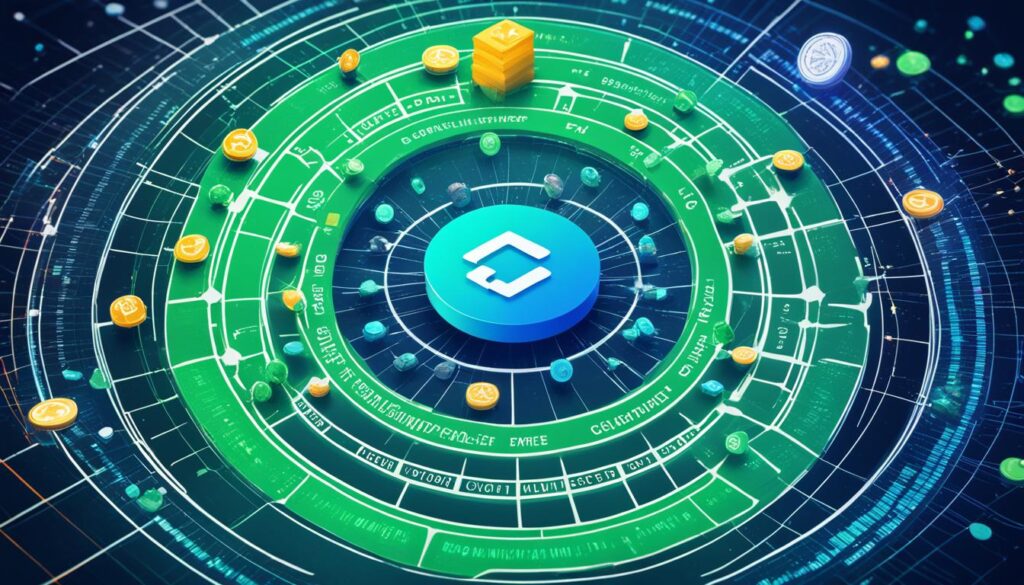Did you know that there are billions of dollars locked in liquidity pools within the DeFi ecosystem? These pools are not just a small part of decentralized finance, but rather they are the backbone that enables decentralized trading, lending, yield farming, and more. Liquidity pools have revolutionized the way digital assets are traded and provided countless earning opportunities for participants in the DeFi space.
Key Takeaways:
- Liquidity pools are a fundamental technology in the DeFi ecosystem.
- They allow for decentralized trading, lending, yield farming, and more.
- Liquidity providers add funds to the pools and earn trading fees.
- Popular liquidity pools operate on Ethereum and BNB Chain.
- They provide the necessary liquidity for decentralized exchanges to function effectively.
How Liquidity Pools Work
Liquidity pools play a vital role in the functioning of decentralized exchanges by enabling the seamless flow of digital assets. These pools operate on the principles of automated market makers (AMMs), which determine token prices and execute trades based on supply and demand.
When liquidity providers deposit their assets into a liquidity pool, the smart contract uses them to facilitate trades. These assets, such as ERC-20 tokens on Ethereum or BEP-20 tokens on BNB Chain, form the basis for trading activities within the pool.
The automated market makers within liquidity pools ensure that traders have access to liquidity at all times. Instead of relying on traditional order books, AMMs calculate token prices based on the predetermined algorithm implemented in the pool’s smart contract. The most common AMM model is the constant product formula, as seen in Uniswap and many other decentralized exchanges.
The prices of tokens within the pool are determined by the ratio of each token’s quantity to the total liquidity in the pool. When a trade occurs, the AMM algorithm adjusts the quantities of the tokens to maintain balanced prices.
Liquidity providers, who contribute assets to the pool, are rewarded with trading fees. These fees are paid by traders who conduct transactions within the liquidity pool. The rewards are proportional to the liquidity provider’s share of the total pool’s liquidity. Liquidity providers have the flexibility to add or withdraw their assets from the pool at any time, allowing for dynamic liquidity management.
Illustrative Example:
| Liquidity Provider | Liquidity Contribution | Percentage Share | Trading Fees Earned |
|---|---|---|---|
| Provider A | 100 ETH | 50% | 0.5 ETH |
| Provider B | 50 ETH | 25% | 0.25 ETH |
| Provider C | 50 ETH | 25% | 0.25 ETH |
As shown in the table, if a total of 200 ETH is deposited into a liquidity pool, Provider A contributes 50%, Provider B contributes 25%, and Provider C also contributes 25%. When trading occurs within the pool, Provider A would earn 50% of the trading fees generated, while Providers B and C would each earn 25% of the fees.
By participating in liquidity pools, providers not only earn trading fees but also contribute to the liquidity and efficiency of decentralized exchanges. This mutually beneficial relationship between liquidity providers and the decentralized finance (DeFi) ecosystem strengthens the overall growth and sustainability of the industry.
The Importance of Liquidity Pools in DeFi
Liquidity pools play a crucial role in the decentralized finance (DeFi) ecosystem, providing the necessary liquidity for decentralized exchanges to operate efficiently. By removing the need for centralized intermediaries, liquidity pools enable users to trade digital assets freely and securely.
At the heart of liquidity pools are liquidity providers, individuals or entities that contribute their assets to the pools. These providers play a vital role in ensuring that there is sufficient liquidity available for trading activities in the DeFi space. In return for their participation, liquidity providers are rewarded with trading fees and other incentives.
One of the key benefits of liquidity pools is their ability to facilitate yield farming. Yield farming involves users providing liquidity to incentivized pools in exchange for additional tokens and rewards. This strategy allows users to maximize their returns by taking advantage of various protocols’ incentive mechanisms.

An example of this is the phenomenon of liquidity mining, where liquidity providers are rewarded with new tokens in addition to trading fees. This has created an ecosystem where users actively participate in providing liquidity and earn passive income through their contributions.
By ensuring a steady supply of liquidity, these pools foster a vibrant trading environment within the DeFi space. They enable users to engage in decentralized trading, contributing to the growth and adoption of decentralized exchanges.
Overall, liquidity pools are a cornerstone of the DeFi ecosystem, driving trading activity, incentivizing liquidity providers, and fueling yield farming opportunities. Their presence and functionality have revolutionized the way digital assets are traded, providing users with greater control and earning potential.
Conclusion
Liquidity pools are the foundational building blocks of decentralized finance (DeFi), revolutionizing the way digital assets are traded in a permissionless environment. By eliminating the need for centralized intermediaries, liquidity pools provide users with a decentralized trading experience and open up new earning opportunities.
Crucially, liquidity providers play an essential role in these pools, contributing their assets and sharing in the trading fees and rewards. However, it’s important to recognize that there are risks associated with participating in liquidity pools. Impermanent loss, caused by fluctuations in the value of assets held in the pool, and smart contract vulnerabilities are among the potential risks that participants should consider.
Despite these risks, liquidity pools have propelled the growth and innovation of DeFi, with billions of dollars locked in various protocols. They ensure sufficient liquidity for decentralized exchanges and enable activities such as yield farming, where users can earn additional tokens. As developers continue to explore new use cases and improve the efficiency of these fundamental building blocks, liquidity pools will continue to shape the future of DeFi.

Leave a Reply